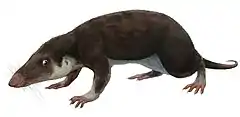Hadrocodium
Hadrocodium wui is an extinct mammaliaform that lived during the Sinemurian stage of the Early Jurassic approximately 195 million years ago[1] in the Lufeng Formation of the Lufeng Basin in what is now the Yunnan province in south-western China[2] (25.2°N 102.1°E, paleocoordinates 34.3°N 104.9°E).[3] It is considered as the closest relative of the class Mammalia.
| Hadrocodium Temporal range: Sinemurian ~ | |
|---|---|
 | |
| Scientific classification | |
| Domain: | Eukaryota |
| Kingdom: | Animalia |
| Phylum: | Chordata |
| Clade: | Synapsida |
| Clade: | Therapsida |
| Clade: | Cynodontia |
| Clade: | Mammaliaformes |
| Genus: | †Hadrocodium Luo, Crompton, & Sun, 2001 |
| Species | |
The fossil of this mouse-like, paper-clip sized animal was discovered in 1985 but was then interpreted as a juvenile morganucodontid.[4] Hadrocodium remained undescribed until 2001; since then its large brain and advanced ear structure[5] have greatly influenced the interpretation of the earliest stages of mammalian evolution, as these mammalian characters could previously be traced only to some 150 million years ago.[6] Hadrocodium is known only from a skull 1.2 cm (0.47 in) long, and its body would have measured 3.2 cm (1.3 in) long in total and weighed up to 2 g (0.071 oz), making it one of the smallest Mesozoic mammaliaforms.[1][7][8] The specimen is thought to have been that of a mature adult.[9]
The name Hadrocodium alludes to its large cranial cavity,[10] deriving from the Greek word hadrós (ἁδρός 'large, heavy, fullness')[4] and the Latin word codium, from Greek kṓdeia (κώδεια 'head [of a plant]').[11] The species name, wui, is the Latinized version of discoverer Xiao-Chun Wu's name.[2]
While initially suggested to have possessed a fully mammalian ear akin to those of modern mammals, a 2022 restudy suggested that it actually had a primitive mandibular middle ear similar to those of other primitive mammaliaforms.[9]
Phylogeny
| Cynodontia |
| ||||||||||||||||||||||||||||||||||||||||||||||||||||||||||||||||||||||||||||||
- Phylogeny [12]
| Mammaliaformes |
| ||||||||||||||||||||||||||||||||||||||||||||||||
References
- Luo, Crompton & Sun 2001, Abstract
- Parsell 2001
- Hei Koa Peng, Lufeng (CUP, IVPP) (Jurassic of China) in the Paleobiology Database. Retrieved April 2013.
- Luo, Crompton & Sun 2001, Note 1
- CNN 2001
- CMNH 2001
- T. S. Kemp (2005). The Origin and Evolution of Mammals. Oxford University Press, USA. p. 183. ISBN 9780198507611. Retrieved 22 September 2022.
- Donald R. Prothero (November 15, 2016). The Princeton Field Guide to Prehistoric Mammals. Princeton University Press. p. 27. ISBN 9780691156828.
- Luo, Zhexi; Bhullar, Bhart-Anjan; Crompton, Alfred; Neander, April; Rowe, Timothy (2022). "Reexamination of the Mandibular and Dental Morphology of the Early Jurassic Mammaliaform Hadrocodium wui". Acta Palaeontologica Polonica. 67. doi:10.4202/app.00949.2021. ISSN 0567-7920.
- Luo, Z.-X. (2001). "A New Mammaliaform from the Early Jurassic and Evolution of Mammalian Characteristics". Science. 292 (5521): 1535–40. Bibcode:2001Sci...292.1535L. doi:10.1126/science.1058476. PMID 11375489. S2CID 8738213.
- Liddell & Scott 1940
- Close, Roger A.; Friedman, Matt; Lloyd, Graeme T.; Benson, Roger B.J. (2015). "Evidence for a mid-Jurassic adaptive radiation in mammals". Current Biology. 25 (16): 2137–2142. doi:10.1016/j.cub.2015.06.047. PMID 26190074.
Bibliography
- "Hadrocodium wui". Carnegie Museum of Natural History. 2001. Archived from the original on 2012-06-17. Retrieved 1 April 2013.
- "Tiny creature may be ancestor of all mammals". CNN. May 24, 2001. Retrieved 1 April 2013.
- Liddell, Henry George; Scott, Robert (1940). "A Greek–English Lexicon: κώδεια". Perseus Digital Library. Retrieved 1 April 2013.
- Luo, Zhe-Xi; Crompton, Alfred W.; Sun, Ai-Lin (2001). "A New Mammaliaform from the Early Jurassic and Evolution of Mammalian Characteristics" (PDF). Science. 292 (5521): 1535–1540. Bibcode:2001Sci...292.1535L. doi:10.1126/science.1058476. PMID 11375489. S2CID 8738213. Archived from the original (PDF) on 2013-08-20.
- Parsell, D.L. (May 24, 2001). "Tiny Fossil From Early Jurassic Fills New Niche in Mammal Evolution". National Geographic News. Retrieved 1 April 2013.
- Rowe, Timothy; Macrini, Thomas E; Luo, Zhe-Xi (May 2011). "Fossil Evidence on Origin of the Mammalian Brain". Science. 332 (955): 955–7. Bibcode:2011Sci...332..955R. doi:10.1126/science.1203117. PMID 21596988. S2CID 940501. (Supporting online material)
External links
- Rowe, Timothy; Macrini, Thomas E; Luo, Zhe-Xi (2006). "Hadrocodium wui (On-line)". Digital Morphology at the University of Texas. Retrieved 1 April 2013. — 3D models from CT scans of the original fossil
- Palaeocritti - a guide to prehistoric animals





